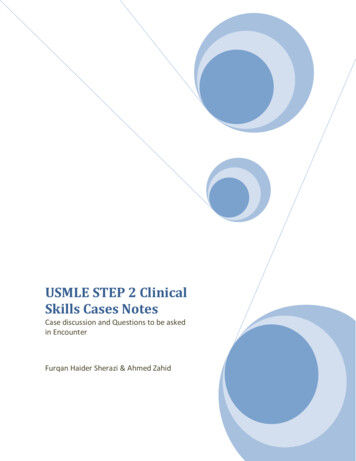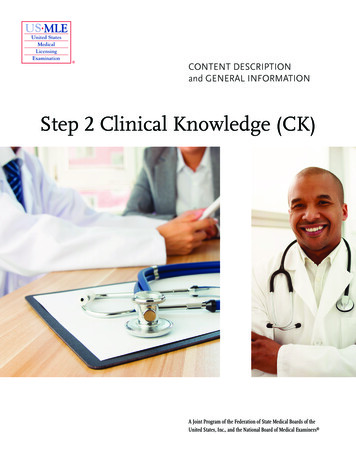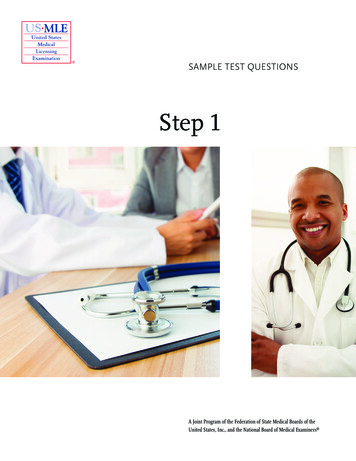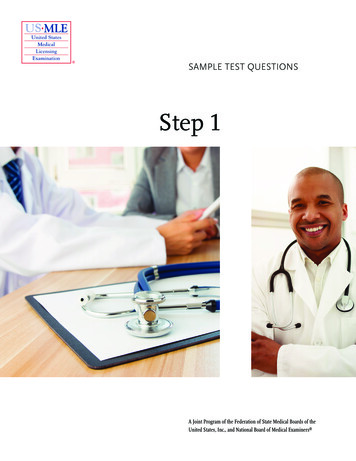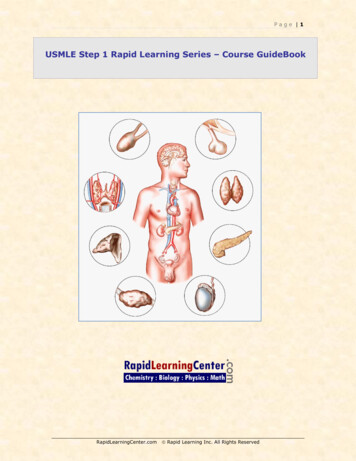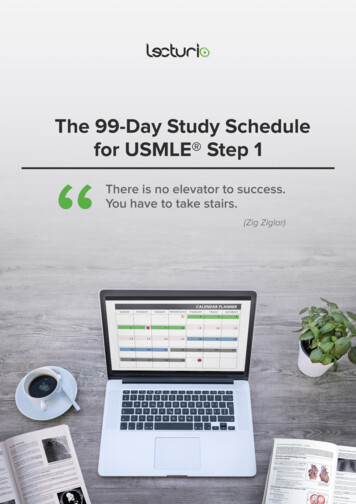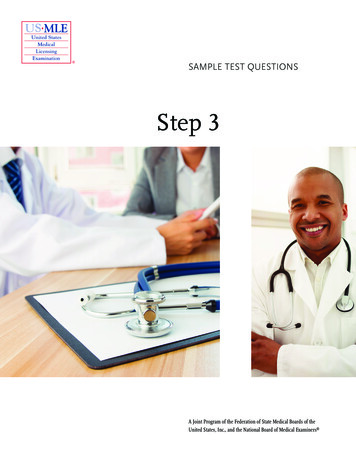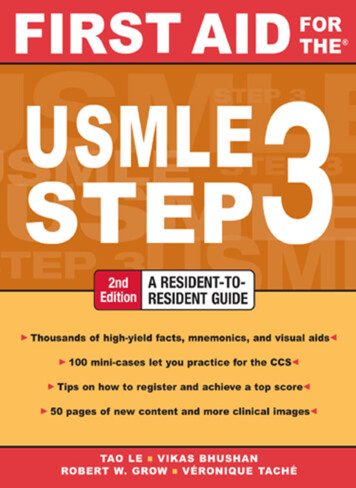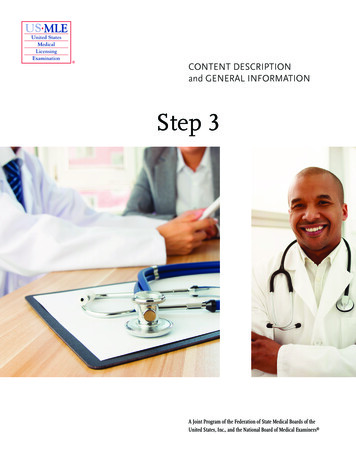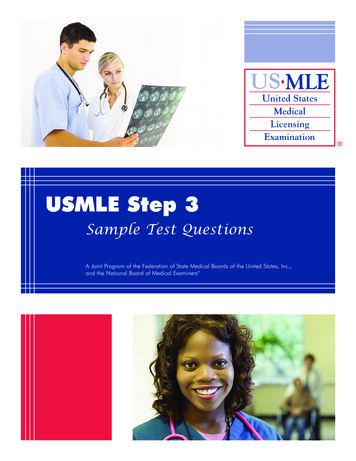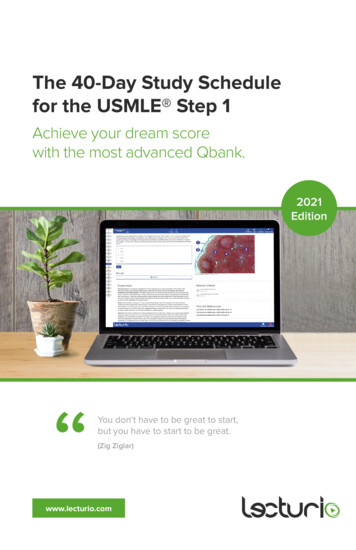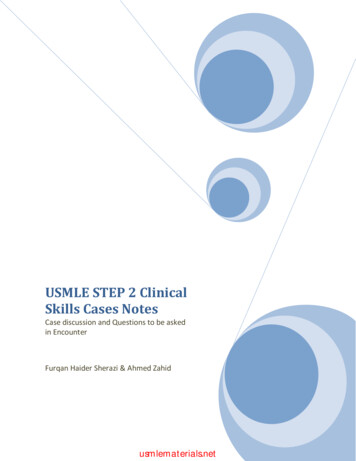
Transcription
USMLE STEP 2 ClinicalSkills Cases NotesCase discussion and Questions to be askedin EncounterFurqan Haider Sherazi & Ahmed Zahid1usmlematerials.net
2014 FHS & AZAll rights reserved. No part of this publication may be reproduced, stored in a retrieval system, ortransmitted, in any form or by any means, electronic, mechanical, photocopying, recording and/orotherwise, without the prior written permission of the publishers.DisclaimerThe authors of this work have checked with resources believed to be relevant and current in their effortsto deliver information that is thorough and in agreement with the criterions accepted at the time ofpublication. However, in view of the possibility for human error or changes in USMLE guidelines, neitherthe authors or the publisher nor anyone else who has been involved in the preparation or publication ofthis work warrants that the information enclosed in “USMLE STEP 2 Clinical Skills Cases Notes” isadequate as a solo preparatory tool. They renounce all obligation for any errors or omissions or for theresults acquired from practice of the information contained in this work. Examinees are encouraged toratify the information contained herein with other sources.Compiled and Typed by Furqan Haider Syediusmlematerials.net
.PrefaceThe most dreaded of USMLE exams for IMGs, the Step 2 CS, is also one of the most integral parts of yourapplication for residency. There are many reasons for why IMGs find this exam difficult, and this workhelps allay one of this aspects, “What question should I be asking my patient?” We are very glad topresent you with the notes that we compiled during our preparation for USMLE STEP 2 CS Exam. Wewould especially like to thank Dr. Majid Aized, Dr. Waqas Ahmed Khan, Dr. Sajeel Anwar, and Dr. UsamaAhmad without whose guidance and support we could not have completed this work. We would be veryhappy if it can help anyone during the preparation and in pursuit of their post graduate medical trainingin US, of which USMLE step 2 CS is a core part.We would also like to provide few suggestions to ensure optimum utilization of these notes: These notes should be complimented with CS notes by Dr. Majid Toseef Aized. We followed thegeneral outline of how a patient encounter should be as detailed in Dr. Majid’s Notes. (There area number of other options such as Iqbalian and Neeraj notes, however we cannot vouch forthem as strongly as we can for Dr. Majid’s.Some medical conditions do not have very specific questions, however pertinent clinicalfeatures can be very easily picked up in the history or review of systems (ROS) and linked toarrive at a diagnosis. Hence in these cases we only mention the features opposite the diagnosisin brackets.The questions have been framed for a person with an average English proficiency, however ifyou feel the need do reframe the question so that its easier for you, albeit ensuring it makesgood literary senseAs part of compilation we decided to include much less common diagnosis as part of ourdifferential as well. We felt it was better to have a longer differential in mind to start your prepwith, but in the later stages when you begin to time your encounters, if you have arrived at adiagnosis, less common causes can be skipped.Do not time your encounters or patient notes the first time around you practice them. Howeverto start timing them in your second round aiming for 15 min for the encounter and 11 min forthe note. By your third and hopefully final round aim for 13 min for encounter and 10 min forpatient note.We made mnemonics that we felt would be easy for us to recall, however if you need to comeup with your own that would definitely be very helpful.These notes do not replace texts like First Aid to CS and U. World and we feel that these textsshould also be reviewed alongside these notes, especially for writing Patient Note.Start typing patient notes from the very first day of preparation of USMLE STEP 2 CS Exam.Don’t be shy!!Improve your notes by discussing and showing it to others, as it is a veryimportant component of the exam.Usually 2 examinations should be done during patient encounter, we recommend doingcardiovascular exam as it can be done in a very short time interval.iiusmlematerials.net
Try practicing the cases multiple times and at least a few times with someone other than yourregular study partner as this will significantly help improve confidence. This also helps attemptunexpected cases as the general pattern used is the same.We wish all of you best of luck for the exams.Dr. Furqan Haider Syedfurqan.sherazi@gmail.comDr. Ahmed Zahidahmed.zhd@gmail.comiiiusmlematerials.net
Table of ContentsAdult Cases. 1Upper Abdominal Pain. 2Diarrhea . 3Blood in Stools . 5Lower Abdominal Pain . 7Testicular Pain . 9Knee Pain . 10Arm Pain. 11Back Pain . 13Neck Pain . 14Heel Pain . 15Hip Pain . 16Calf Pain . 17Chest pain . 18Palpitations . 19Anxiety . 20Cough. 21SOB . 23Sore Throat. 25Hoarseness . 26Jaundice . 27Hematuria . 28ivusmlematerials.net
Burning Micturition . 29Urinary Incontinence . 30Fatigue . 31DM and HTN follow- up . 33Pre-Employment Exam . 34Headache . 35Forgetfulness . 37Hearing Loss . 39Dizziness (Vertigo) . 40Dizziness (LOC) . 41Menstrual Irregularities . 43Post-Menopausal Bleeding . 45Vaginal Discharge . 46Dyspareunia . 47Sleep Problems/Insomnia . 48Weight Gain . 49Weight Loss . 50Tremors. 51Muscle Weakness . 52Hallucinations . 54Seizures . 56Pediatric Case. 57Fever . 59vusmlematerials.net
Seizures . 61Diarrhea . 62Cough. 63Picky Eater. 64viusmlematerials.net
Adult Cases1usmlematerials.net
Download More Books - USMLE Notes:Medbook4u.comusmlematerials.net
Upper Abdominal PainMnemonic: TRYS DHIBEDifferential Diagnosis: Stomach: Gastritis, GERD, Gastric cancerPancreas: Pancreatitis, Pancreatic cancerRUQ: Hepatitis, CholecystitisMIQuestions1.2.3.4.5.6.7.8.9.What Type of food aggravates the pain?Is there any Relationship between pain and timing of your food intake?Have you noticed any Yellowness of your eyes or skin?Have you noticed any Distension of your belly?Have you noticed any burning sensation in your chest (Heart Burn) or change in taste of yourmouth?Have you ever been exposed to anybody with similar complaints (Infections)?Have you noticed any change in color of your stools or any Blood in the stools?Have you Eaten anything from outside recently?Have you noticed any shortness of breath? Any sweating?Exam1. HEENT2. GIT exam (including Murphy’s sign)3. CVSInvestigations1.2.3.4.5.6.7.8.Rectal & Pelvic ExamEKGStool for occult bloodALT/AST/Bilirubin/ALPU/S AbdomenUpper GI EndoscopyHIDA scanNoninvasive H. Pylori testing2usmlematerials.net
DiarrheaDifferential Diagnosis: Watery, Bloody, MalabsorptionWatery: GC PHAIL. Gastroenteritis/Travelers, Crohn’s Disease, Pseudomembranous Colitis,Hyperthyroidism, AIDS, IBS, Lactose Intolerance.Bloody: Ulcerative Colitis, Dysentery, Cancer.Malabsorption: Pancreatitis, Giardiasis, Celiac Disease.OFDPAA questionsWhat do you mean by diarrhea? (You want to find out ---Do you mean increased frequency or increasedvolume?)What do your stools look like? (You want to find out --- Are they watery or bloody or fatty? Are yourstools abnormally foul smelling?)For Watery Diarrhea:1. For Gastroenteritis/Travelers’ Diarrhea:a. Have you eaten outside recently?b. Have you travelled recently?2. For Crohn’s Disease:a. Have you noticed a sense of incomplete evacuation after passing stools?b. Have
Start typing patient notes from the very first day of preparation of USMLE STEP 2 CS Exam. Don’t be shy!!Improve your notes by discussing and showing it to others, as it is a very important component of the exam. Usually 2 examinations should be done during patient encounter, we recommend doing
